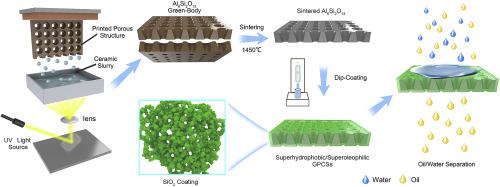Journal of Materiomics ( IF 9.4 ) Pub Date : 2020-08-12 , DOI: 10.1016/j.jmat.2020.07.002 Zhipeng Jin , Hui Mei , Yuekai Yan , Longkai Pan , Hongxia Liu , Shanshan Xiao , Laifei Cheng

|
Superwetting surfaces have the potential to address oil pollution in water, through their ability to separate the two. However, it remains a great challenge to fabricate stable and efficient separation structures using conventional manufacturing techniques. Furthermore, the materials traditionally used for oil-water separation are not stable at high temperature. Therefore, there is a need to develop stable, customizable structures to improve the performance of oil-water separation devices. In recent years, 3D printing technology has developed rapidly, and breakthroughs have been made in the fabrication of complicated ceramic structures using this technology. Here, a ceramic material with a gradient pore structure and superhydrophobic/superoleophilic properties was prepared using 3D printing for high-efficiency oil-water separation. The gradient pore structure developed here can support a flux of up to 25434 L/m2h, which is nearly 40% higher than that an analogous structure with straight pores. At 200 °C, the oil-water separation performance was maintained at 97.4%. Furthermore, samples of the material exhibited outstanding mechanical properties, and chemical stability in a variety of harsh environments. This study provides an efficient, simple, and reliable method for manufacturing oil-water separation materials using 3D printing, and may have broader implications for both fundamental research and industrial applications.
中文翻译:

3D打印的可控梯度孔超湿结构,可实现高温高效油水分离
超湿表面通过将两者分开的能力,有可能解决水中的油污问题。然而,使用常规制造技术来制造稳定且有效的分离结构仍然是巨大的挑战。此外,传统上用于油水分离的材料在高温下不稳定。因此,需要开发稳定的,可定制的结构以改善油水分离装置的性能。近年来,3D打印技术得到了快速发展,并且在使用该技术制造复杂的陶瓷结构方面取得了突破。在此,使用高效油水分离的3D打印技术制备了具有梯度孔结构和超疏水/超亲油特性的陶瓷材料。2小时,比具有直孔的类似结构高出近40%。在200°C下,油水分离性能保持在97.4%。此外,该材料的样品在各种恶劣环境下均表现出出色的机械性能和化学稳定性。这项研究为使用3D打印制造油水分离材料提供了一种有效,简单和可靠的方法,并且可能对基础研究和工业应用都具有更广泛的意义。



























 京公网安备 11010802027423号
京公网安备 11010802027423号